- Главная
- Разное
- Бизнес и предпринимательство
- Образование
- Развлечения
- Государство
- Спорт
- Графика
- Культурология
- Еда и кулинария
- Лингвистика
- Религиоведение
- Черчение
- Физкультура
- ИЗО
- Психология
- Социология
- Английский язык
- Астрономия
- Алгебра
- Биология
- География
- Геометрия
- Детские презентации
- Информатика
- История
- Литература
- Маркетинг
- Математика
- Медицина
- Менеджмент
- Музыка
- МХК
- Немецкий язык
- ОБЖ
- Обществознание
- Окружающий мир
- Педагогика
- Русский язык
- Технология
- Физика
- Философия
- Химия
- Шаблоны, картинки для презентаций
- Экология
- Экономика
- Юриспруденция
Что такое findslide.org?
FindSlide.org - это сайт презентаций, докладов, шаблонов в формате PowerPoint.
Обратная связь
Email: Нажмите что бы посмотреть
Презентация на тему Diferenciace heterocyst
Содержание
- 2. Anabaena sp. PCC 7120 je Nostocheterocysty nejsou cysty
- 4. Paradox of developmental biologyHow is it that
- 5. Patterning can involve the interpretation of positional information.
- 6. Figure 21-63. Two strategies for using signal
- 7. Expression of eve Stripe 2
- 8. Figure 21-65. The formation of ftz and
- 9. The Course of Development
- 10. The Course of DevelopmentTimeEvents in time and space . . .Complicated
- 11. The Course of DevelopmentTimeComplicatedReally
- 12. Matveyev and Elhai (unpublished)N2CyanobacteriaAnabaena grown without fixed nitrogen
- 13. Paradox of developmental biologyHow is it that
- 14. Fixace dusíku
- 15. N2 + 8H+ + 8e- + 16ATP
- 16. What is another problem with nitrogenase?Nitrogenase is
- 17. Ne všechny sinice schopné fixovat dusík tvoří heterocysty
- 21. How does Trichodesmium (and single cell cyano’s)
- 22. 1. Site of N2 fixation in many
- 23. The heterocyst achieves a near anoxic state
- 24. Dělba práce
- 25. Excitation was at 510 to 560 nm
- 26. Anabaena filament growing on nitrateremoval of nitrate18 hoursHeterocysts only when needed
- 27. Anabaenaheterocyst cellsvegetative cells
- 29. Anabaena modelHeterocyst spacing relatively constantHeterocyst cellsproduce compoundVegetative cellsdividedifferentiateconsume compounddiffuse compound
- 30. First, they assumed that any cell is
- 31. Anabaena – continuous modelaxiom: Fh(smax,cmax) Fv(smax,cmax) Fh(smax,cmax)F(sl,cl)
- 32. Anabaena – continuous model
- 33. Case of the Hidden HeterocystMatveyev and Elhai (unpublished)N2NH3O2
- 34. Case of the Hidden HeterocystStrategy to find heterocyst differentiation genes1. Use transposon mutagenesis
- 35. Case of the Hidden HeterocystStrategy to find
- 36. Case of the Hidden HeterocystStrategy to find
- 37. Case of the Hidden HeterocystStrategy to find
- 38. HetRmutant - unable to make heterocystsThe spatially
- 40. HetRGenes needed for differentiationMaster regulatorDifferentiation
- 41. Promoter
- 44. The key result of this experiment is
- 46. PatSoverexpression of patS completely blocks heterocyst developmentpatS
- 47. Wild-type filaments (A) grown in BG-11 medium
- 48. The exogenous addition of a pentapeptide corresponding
- 49. Přesně jako v modeluz roku 1975
- 50. Because it takes ~20 hours for heterocysts
- 51. + Nostoc punctiformeAnthoceros punctatus.
- 54. Další události nezbytné k aktivaci nif genů
- 66. Скачать презентацию
- 67. Похожие презентации
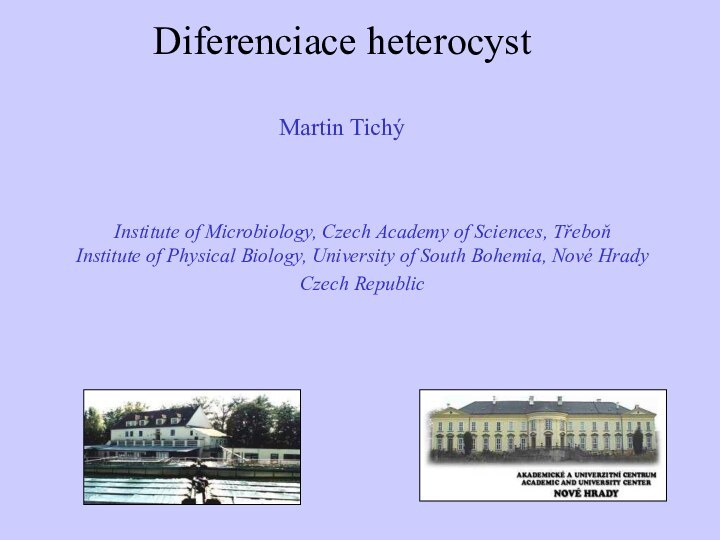
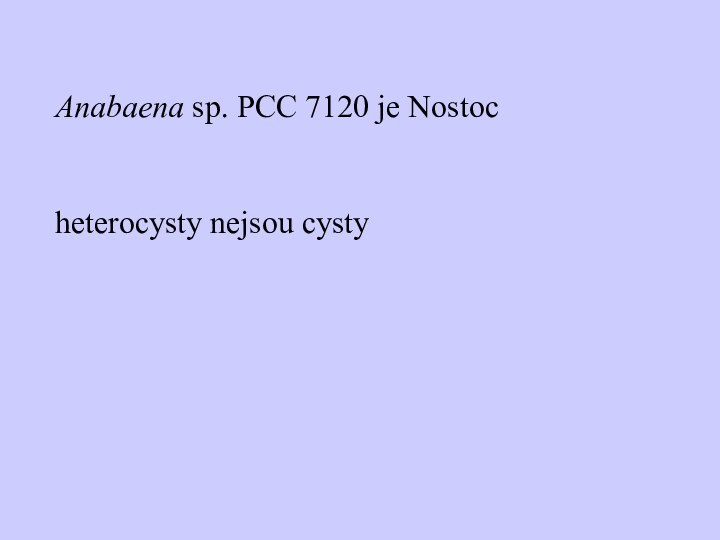
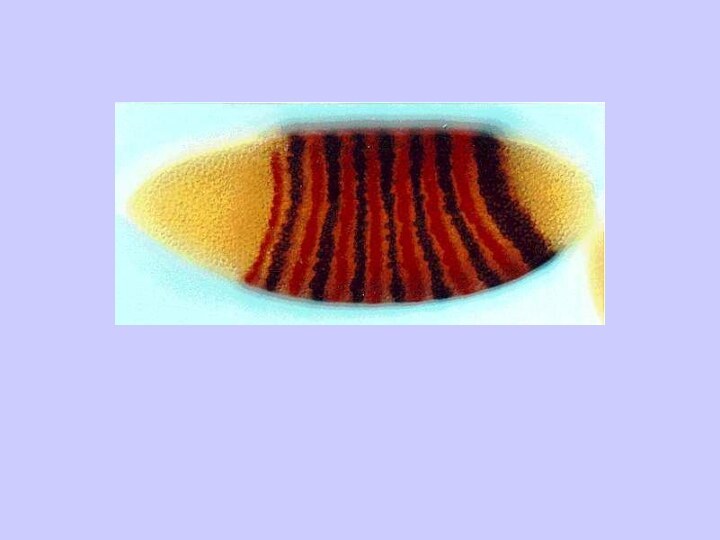
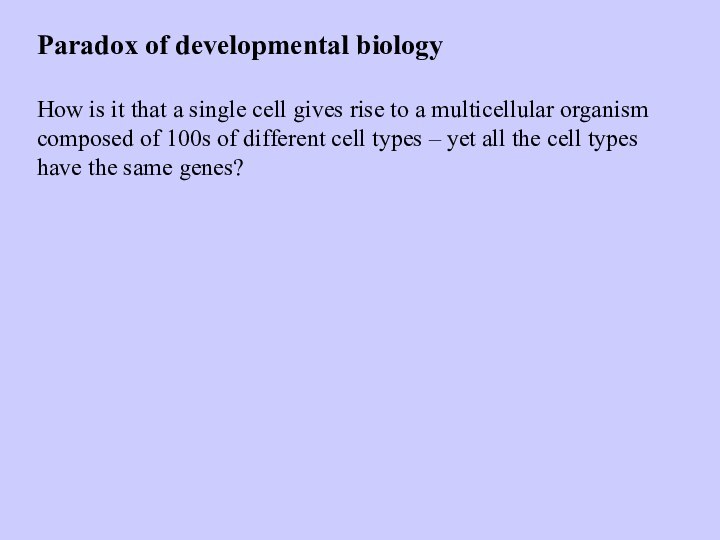
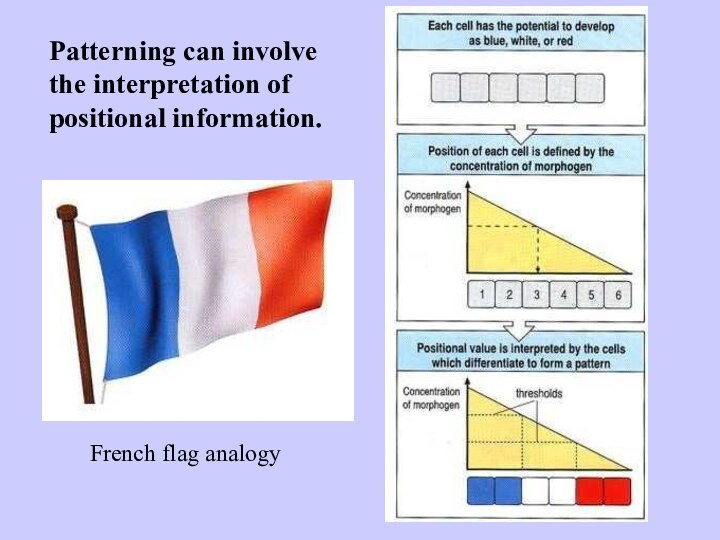
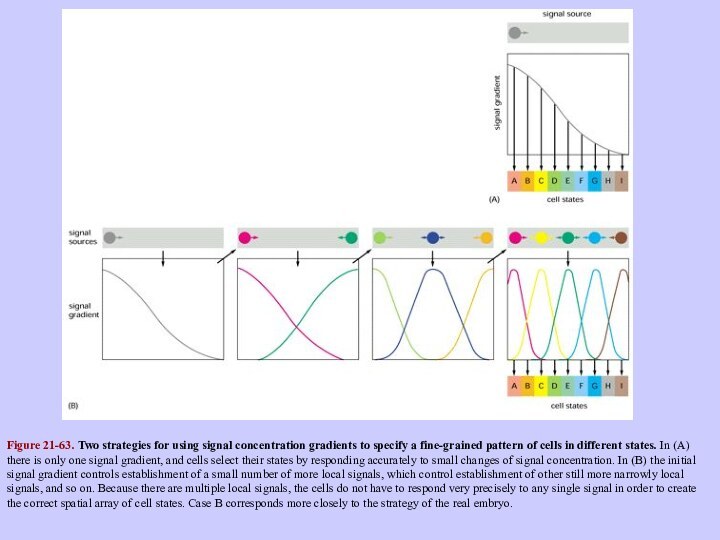
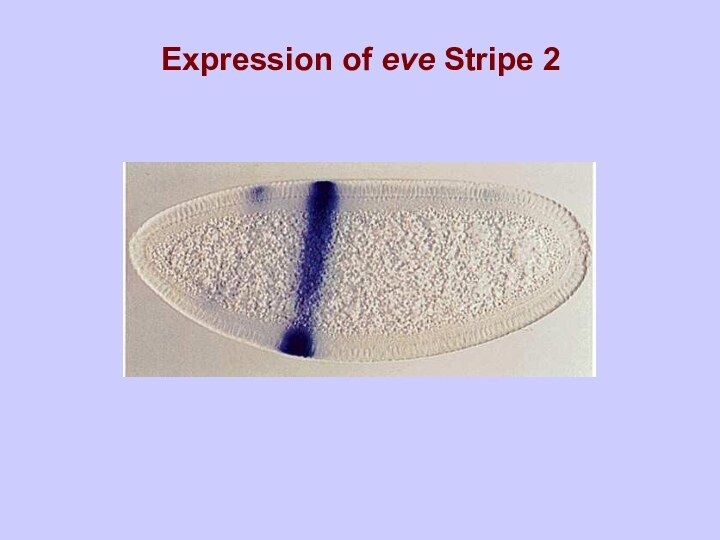
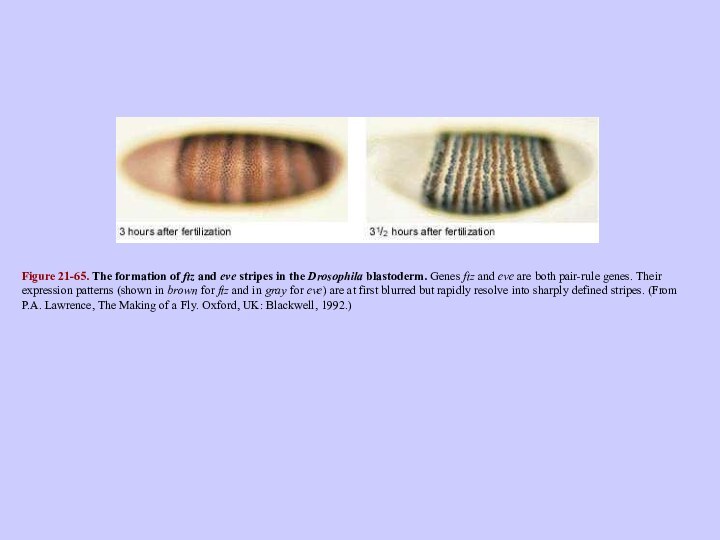
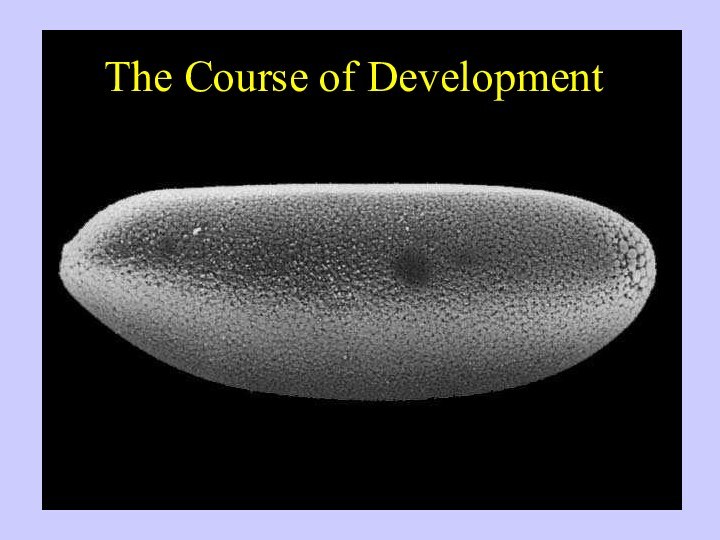
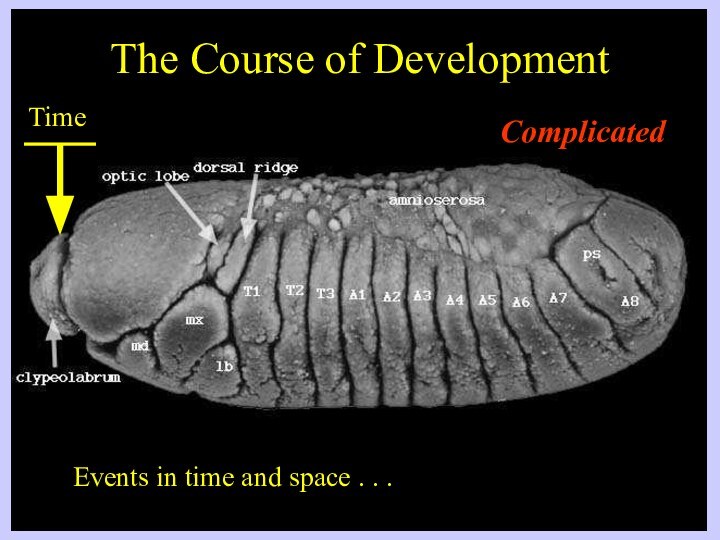
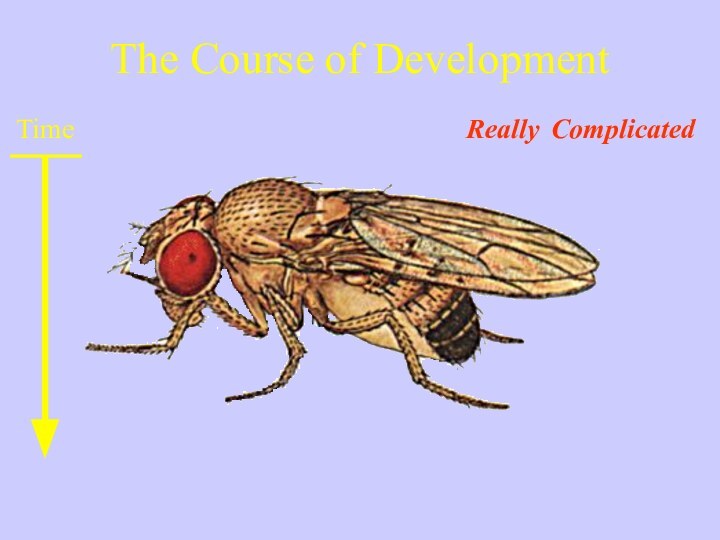
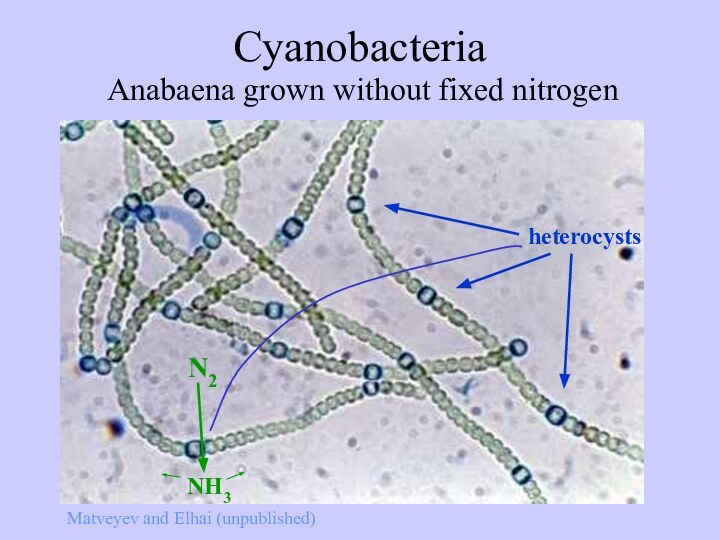
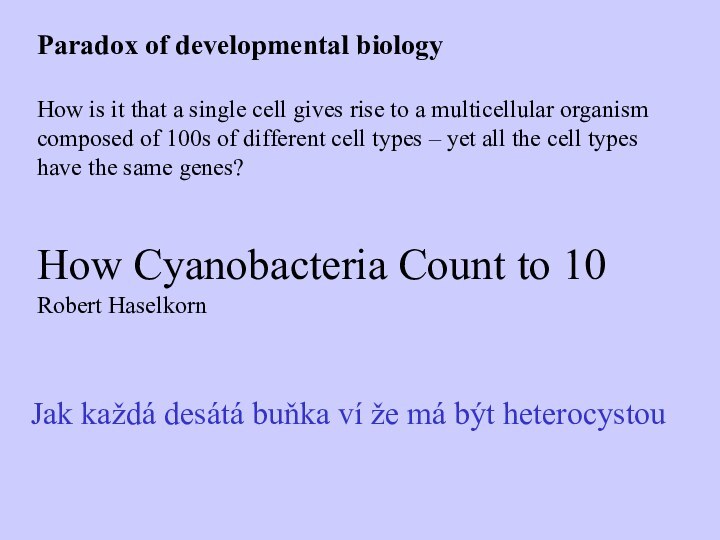
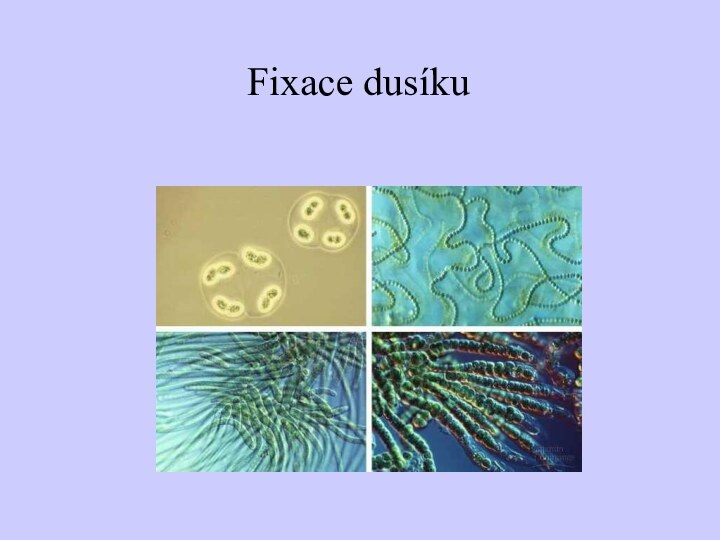
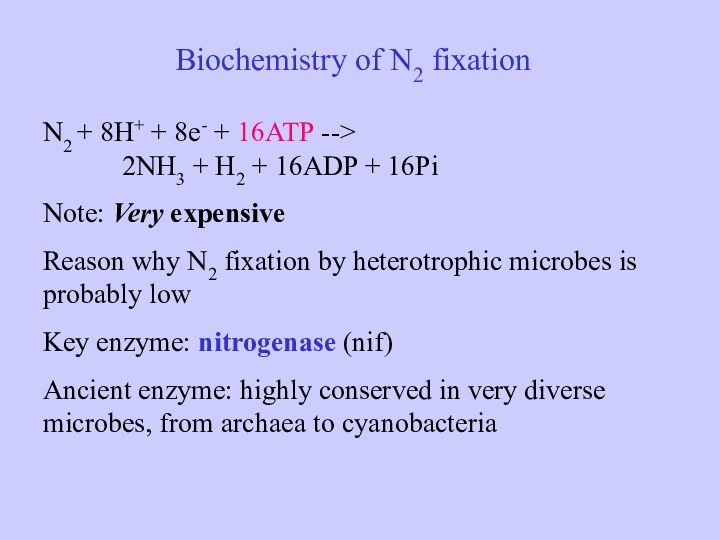
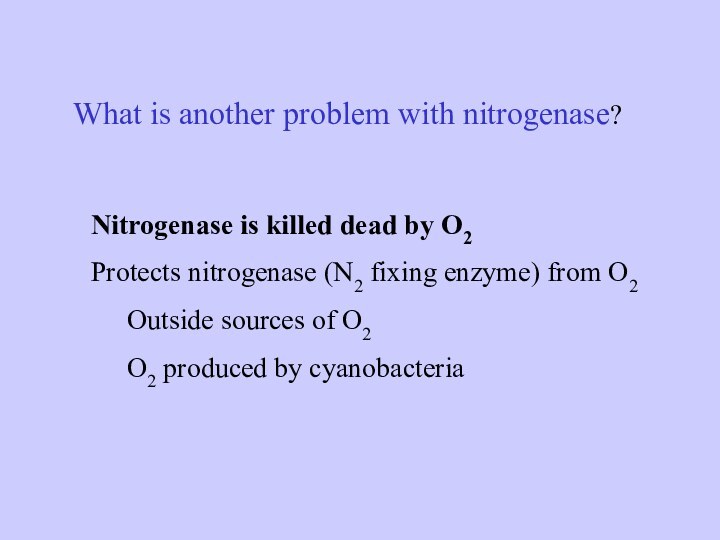
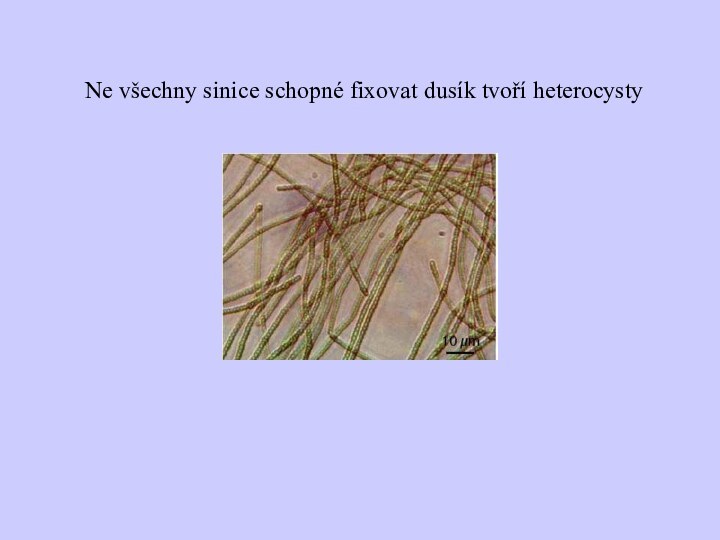
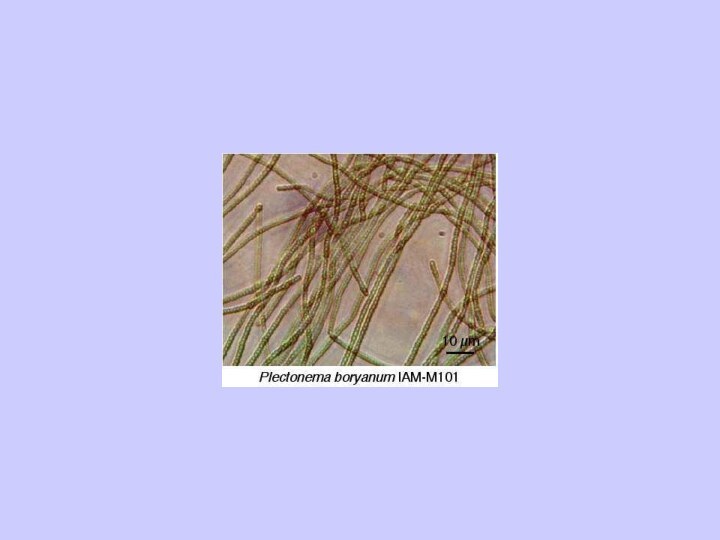
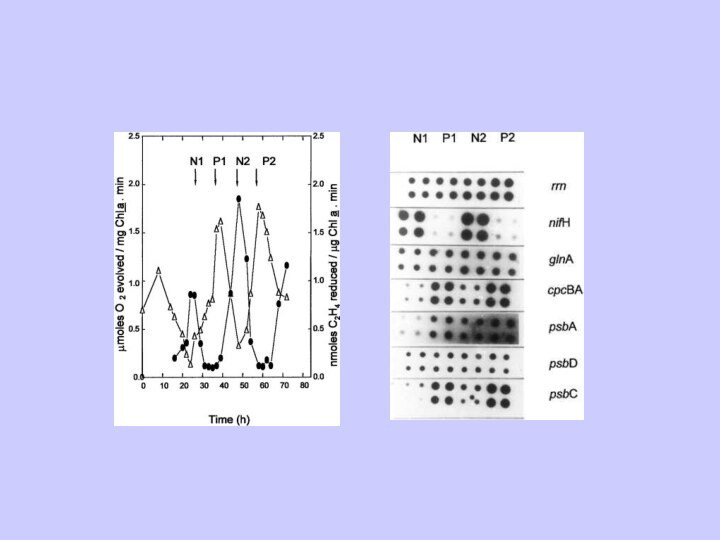

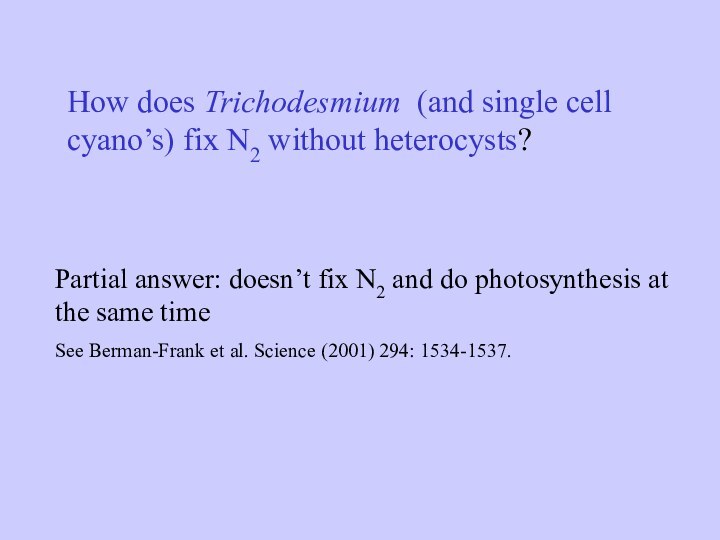
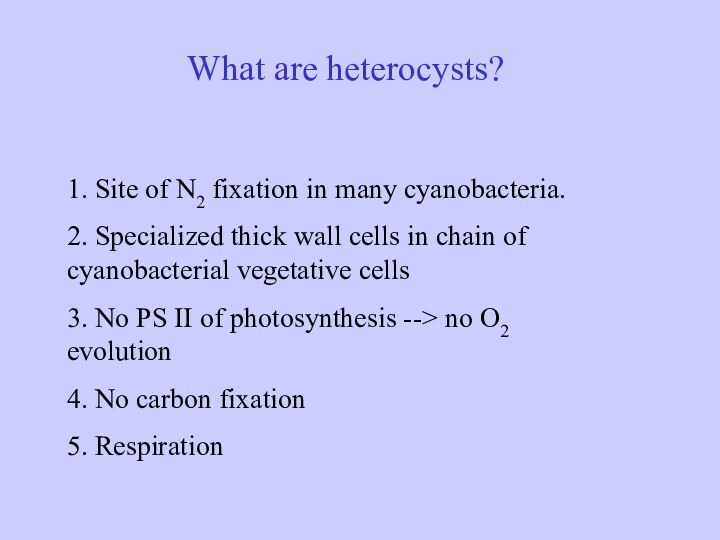
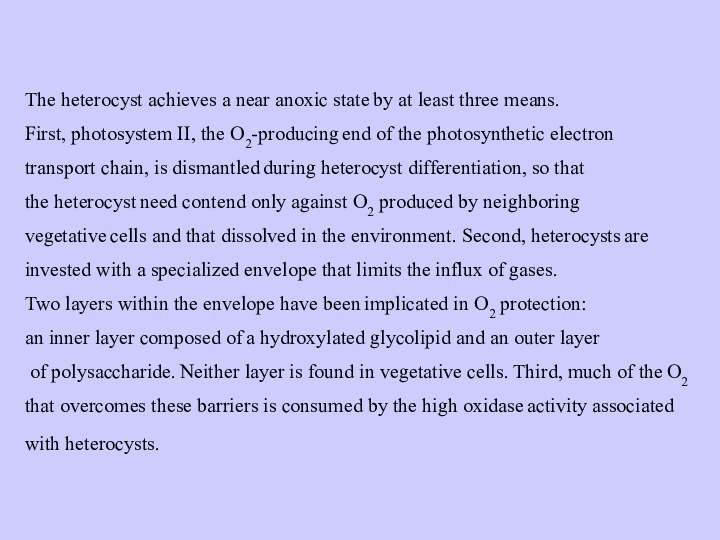

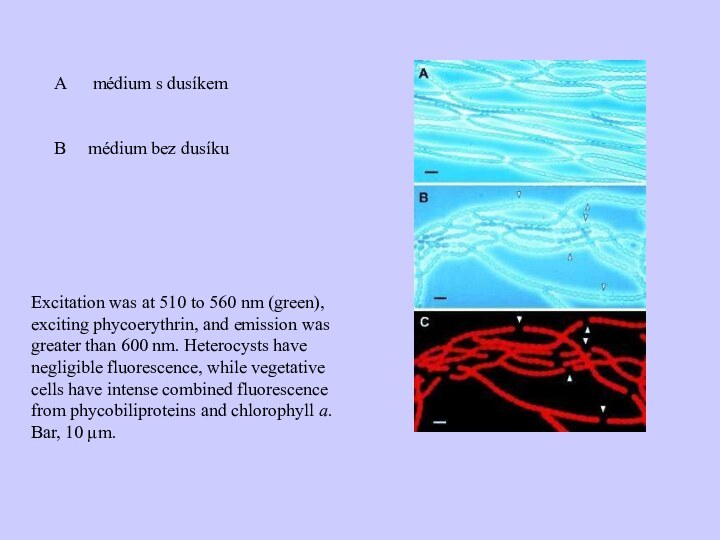
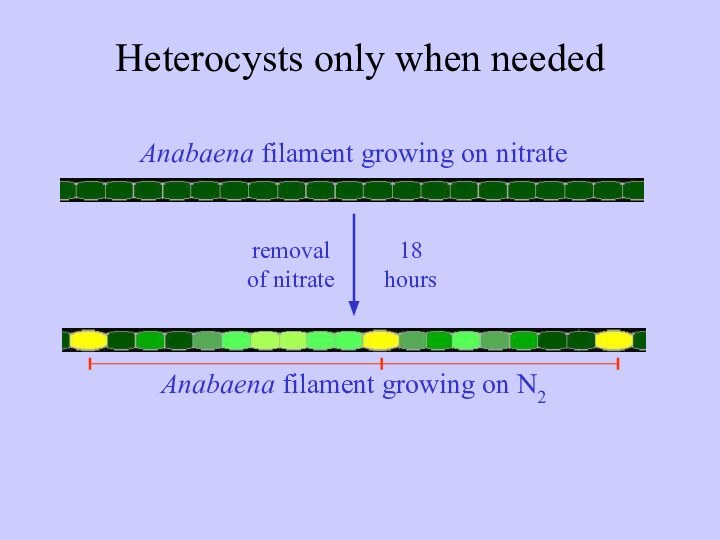
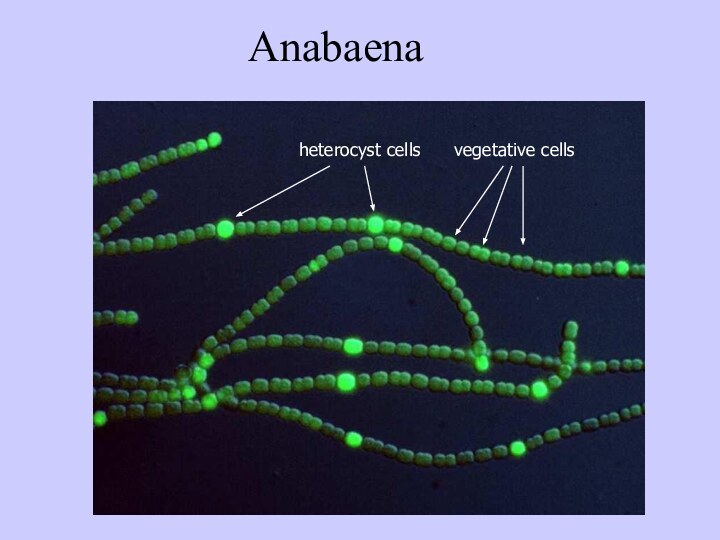
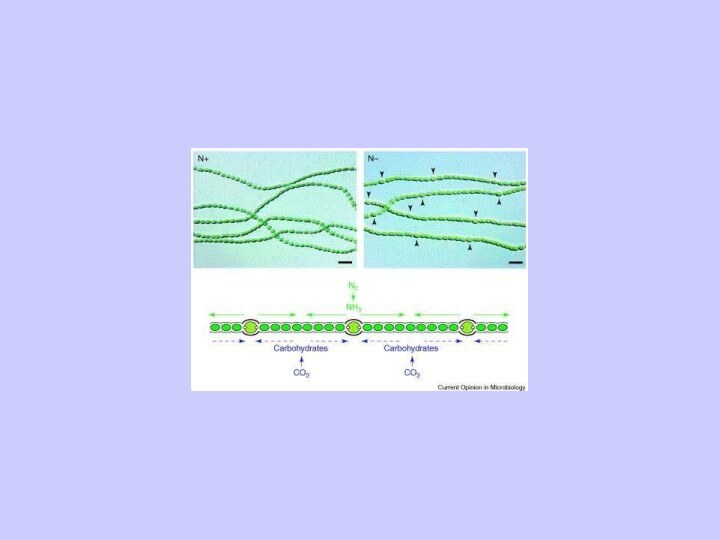
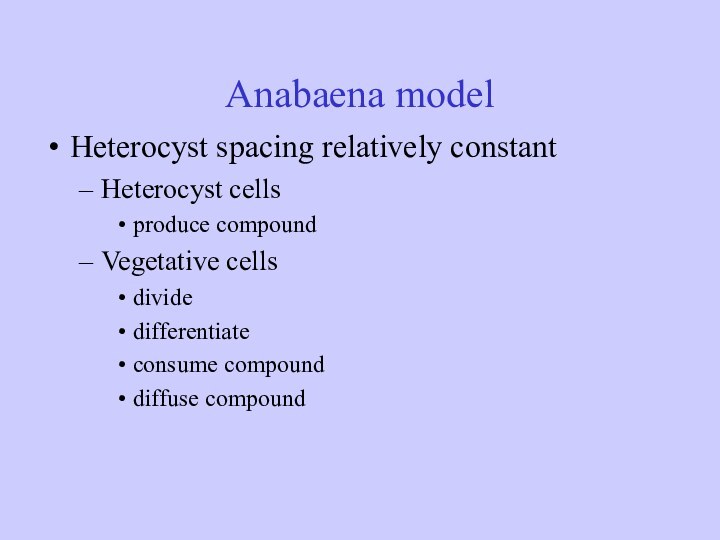
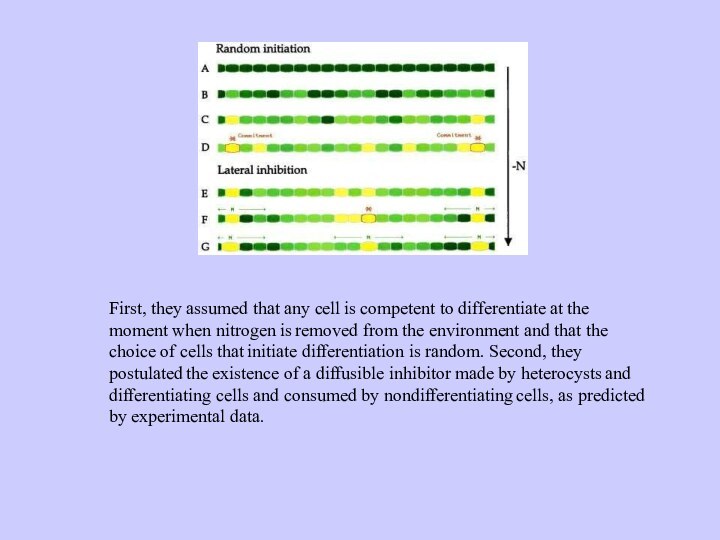
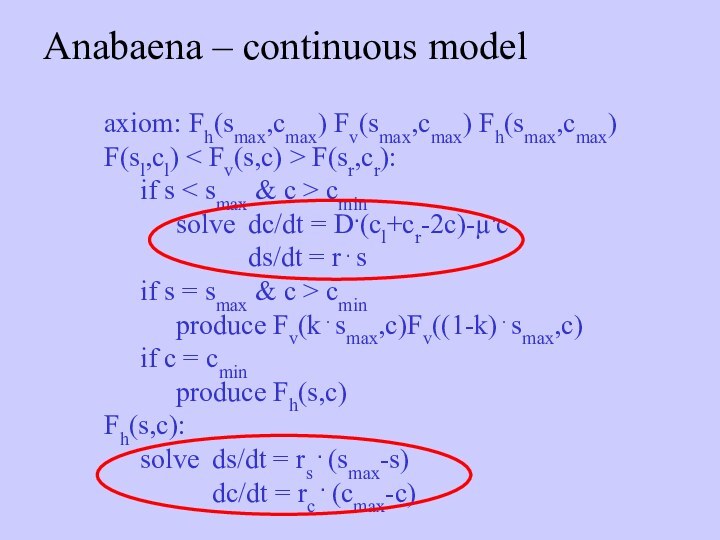
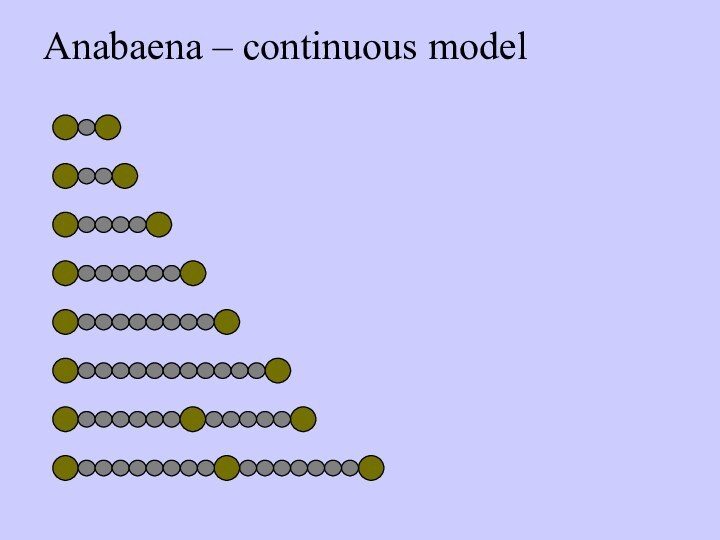
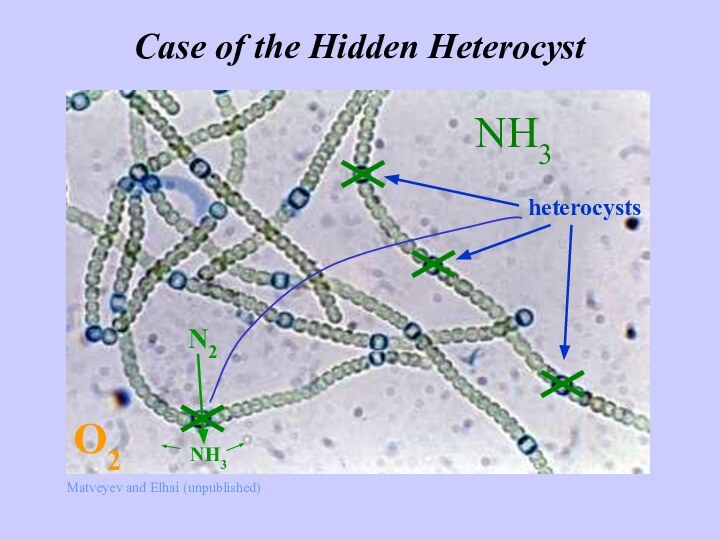
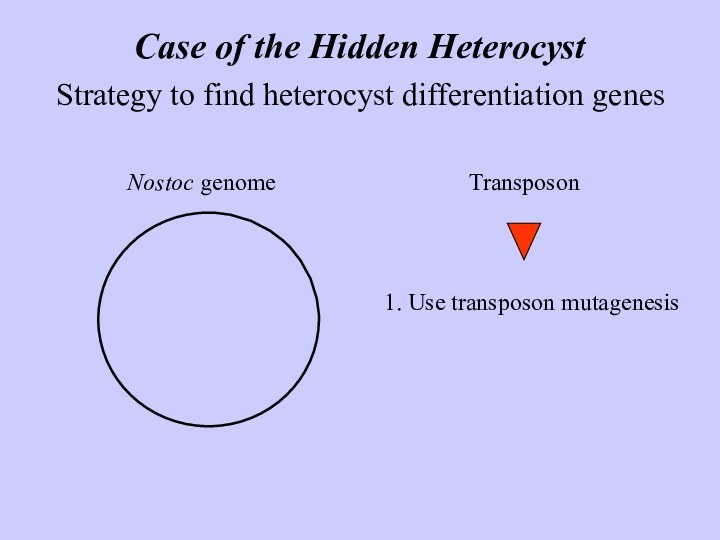
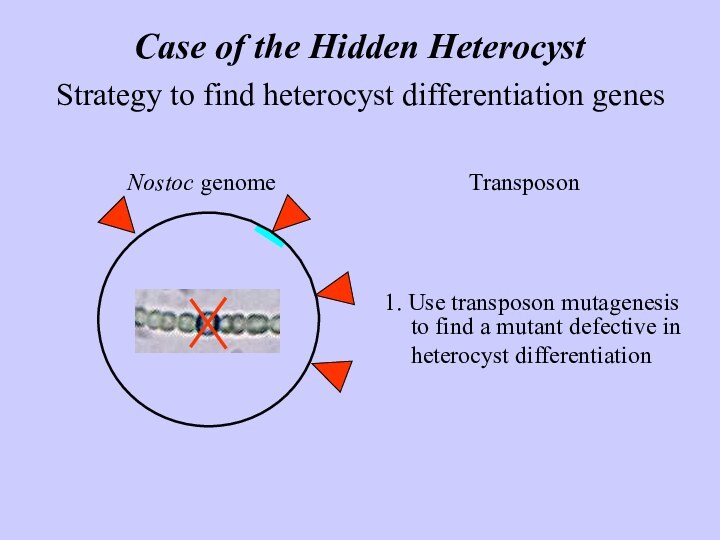
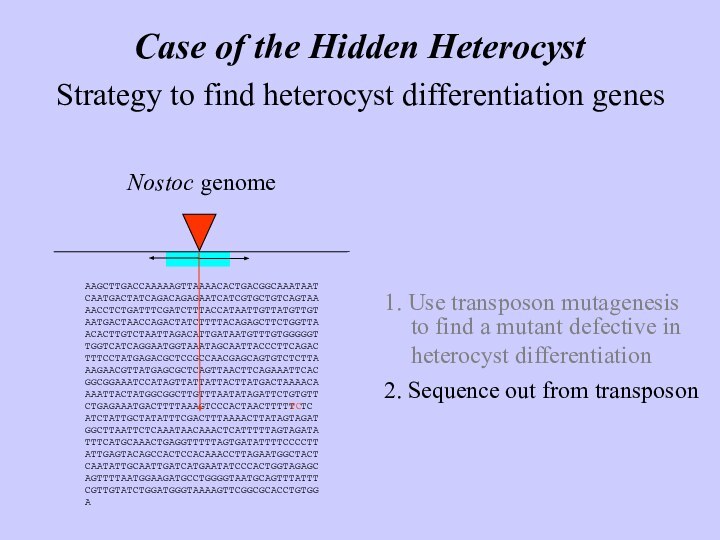
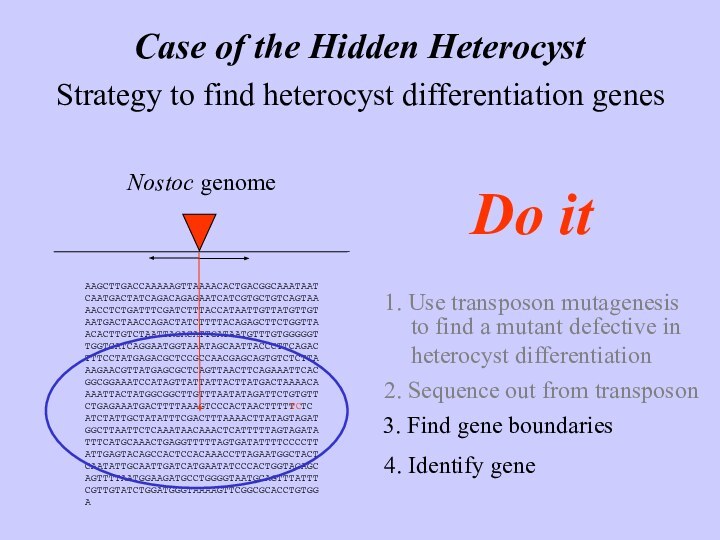
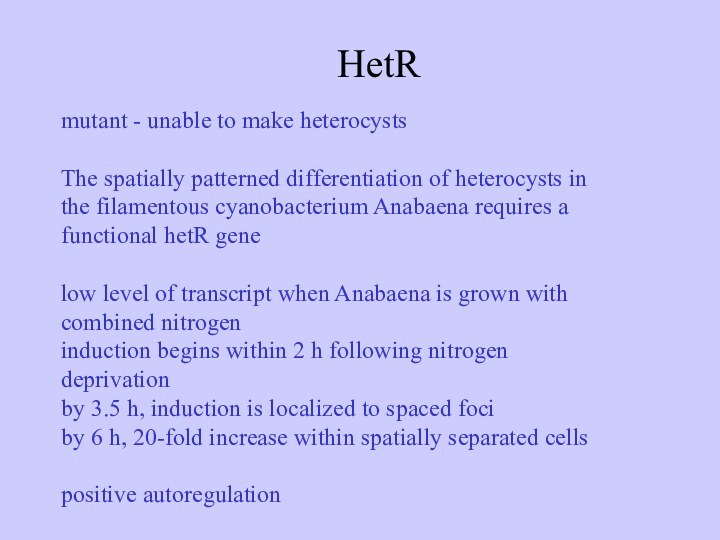
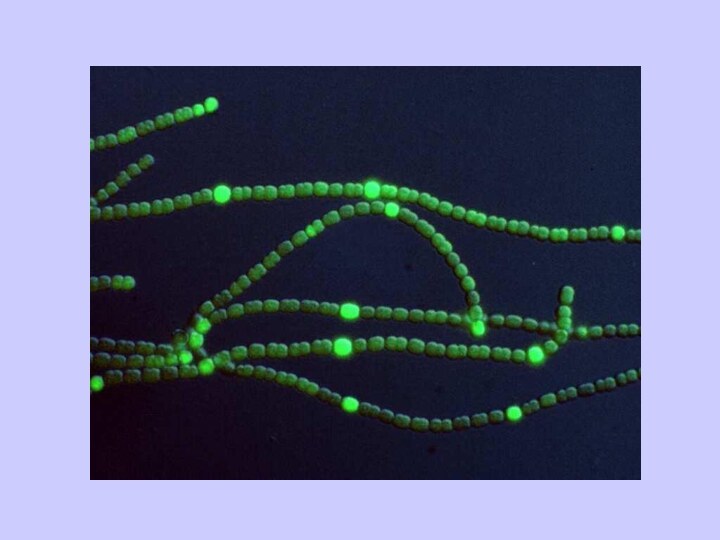
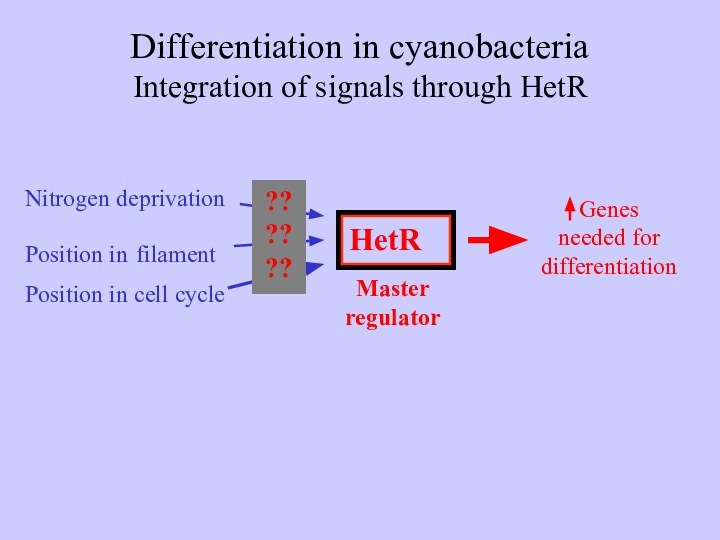
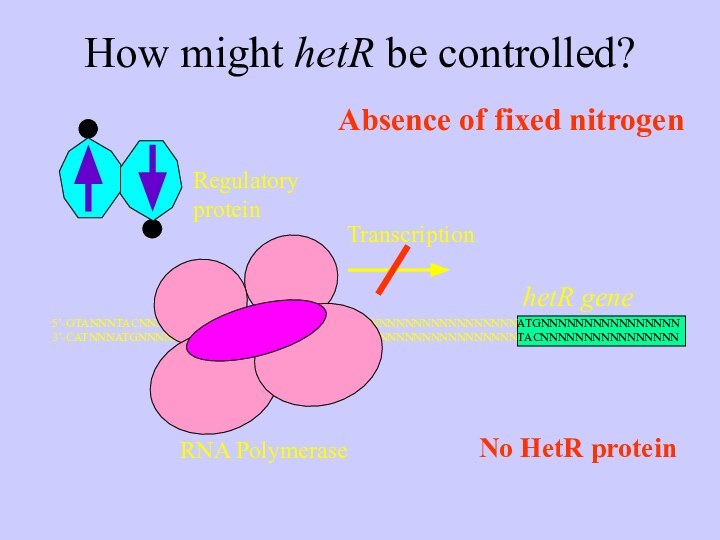
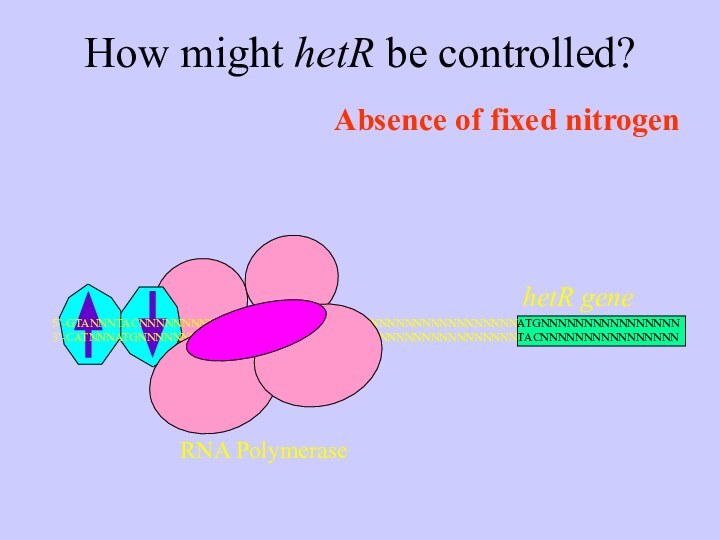
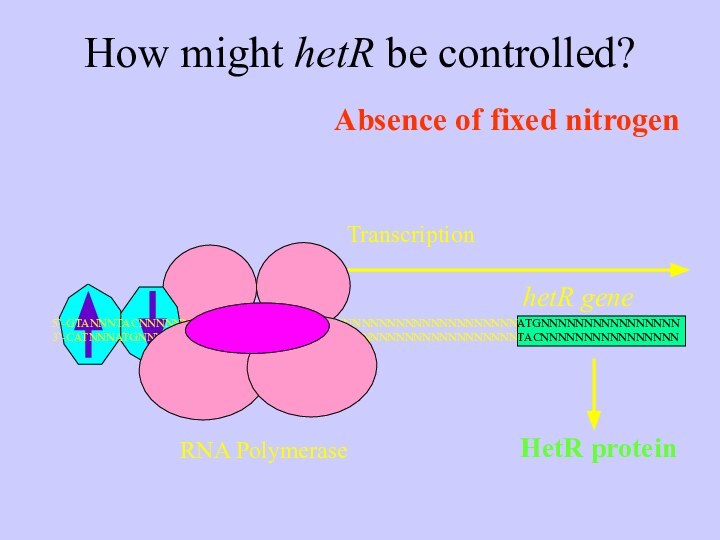
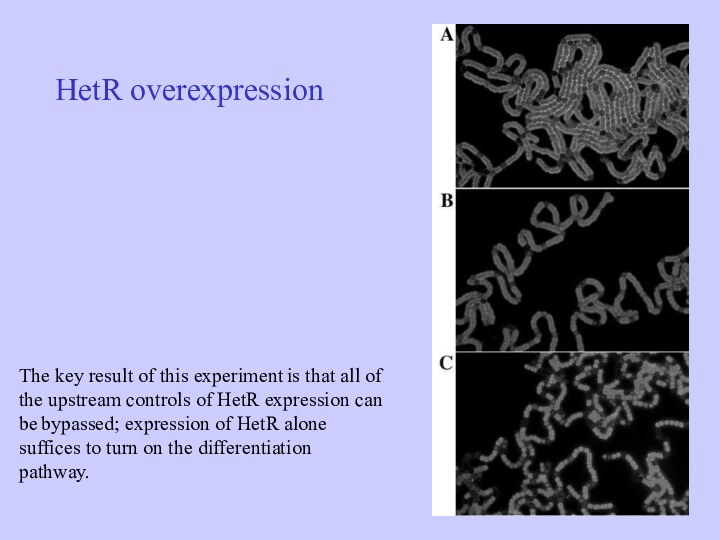
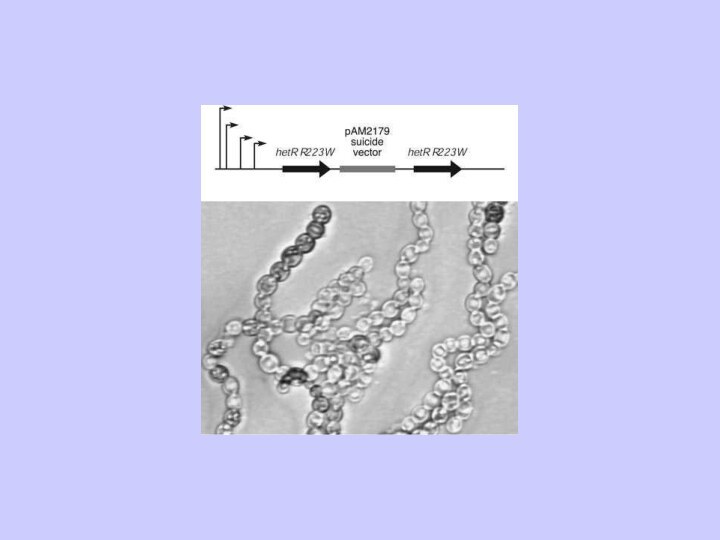


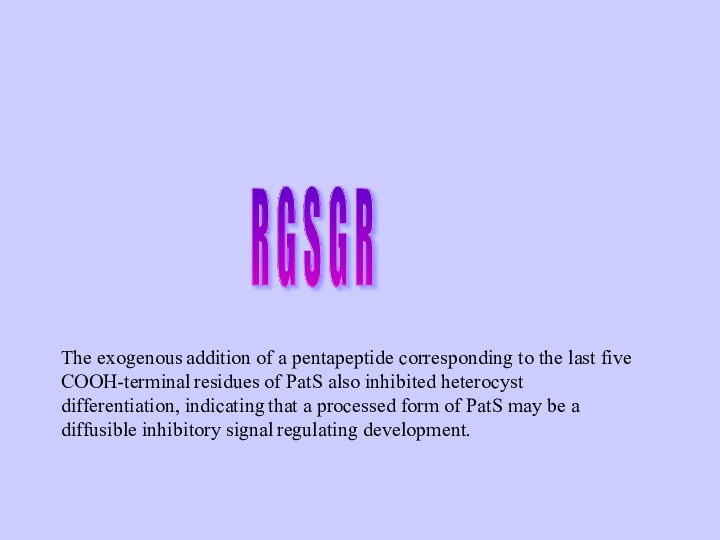
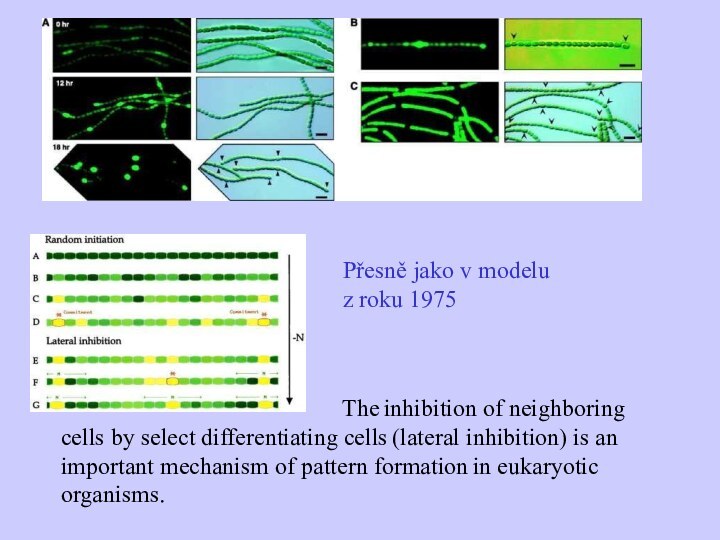
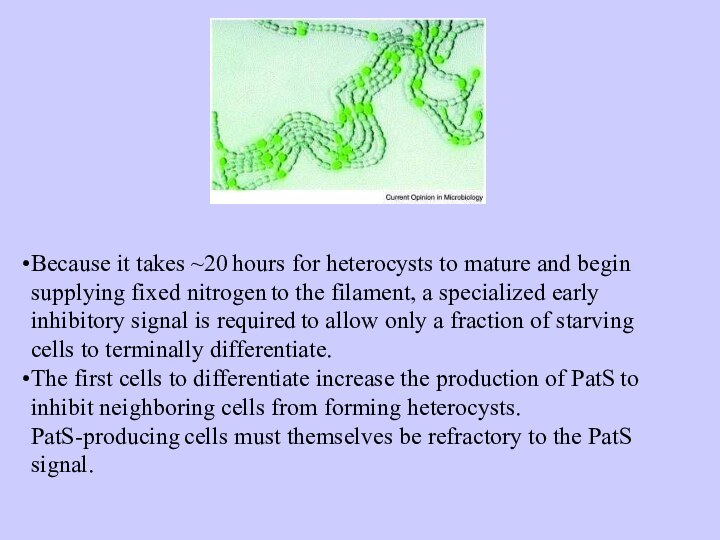
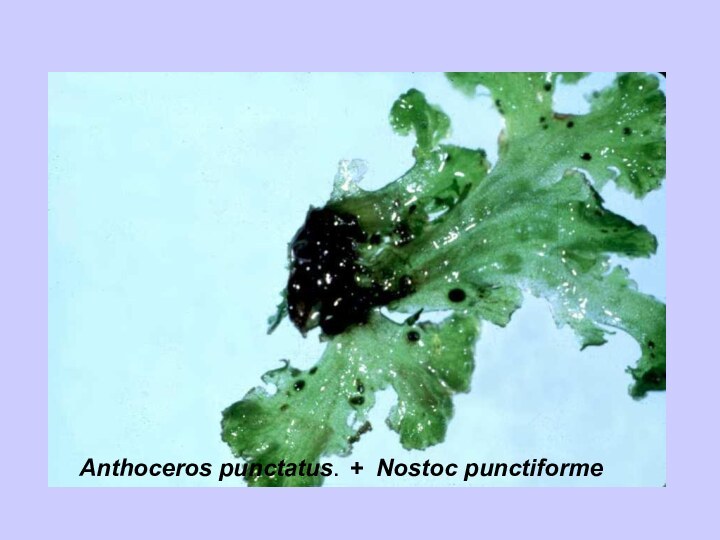
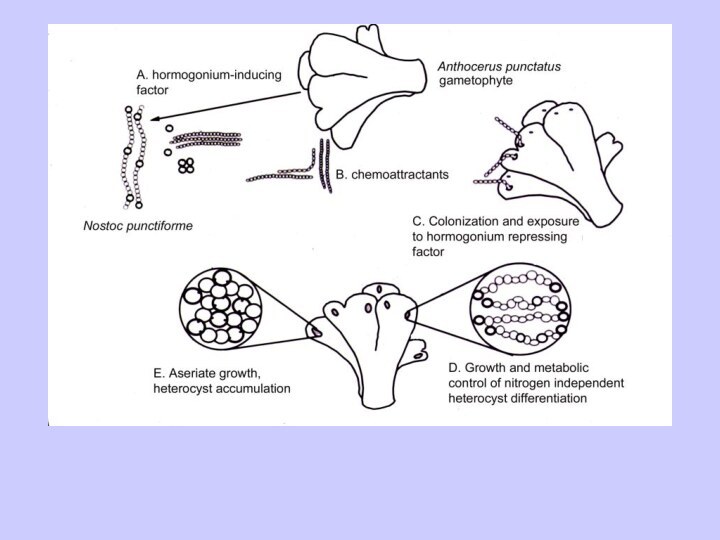
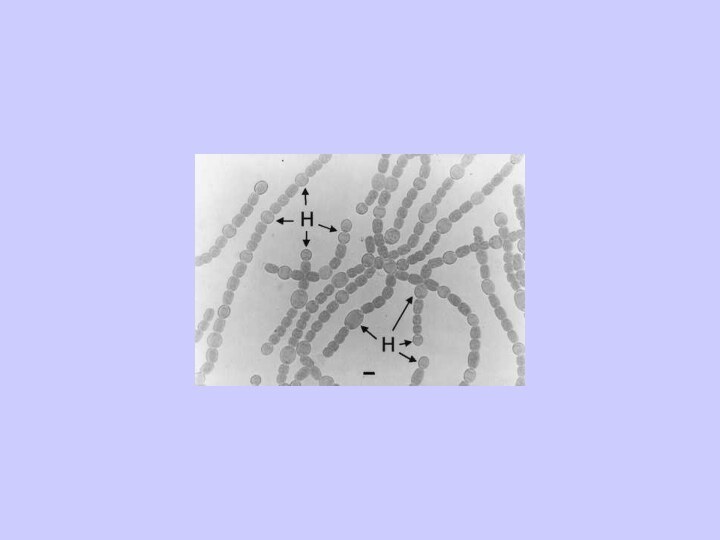
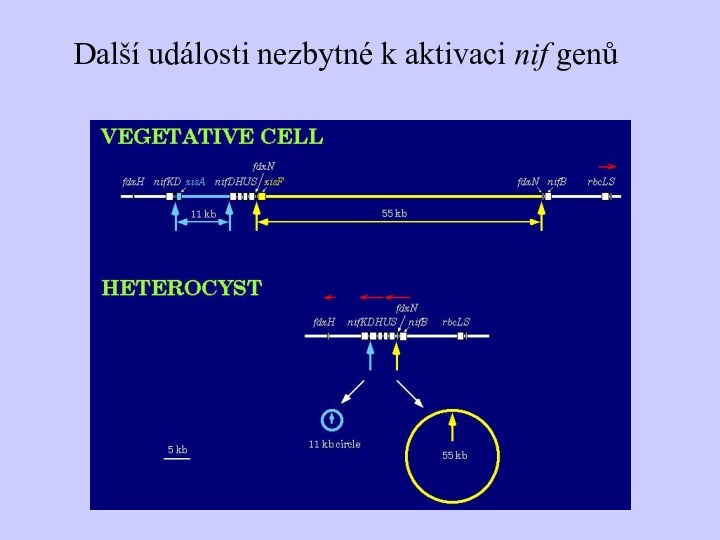
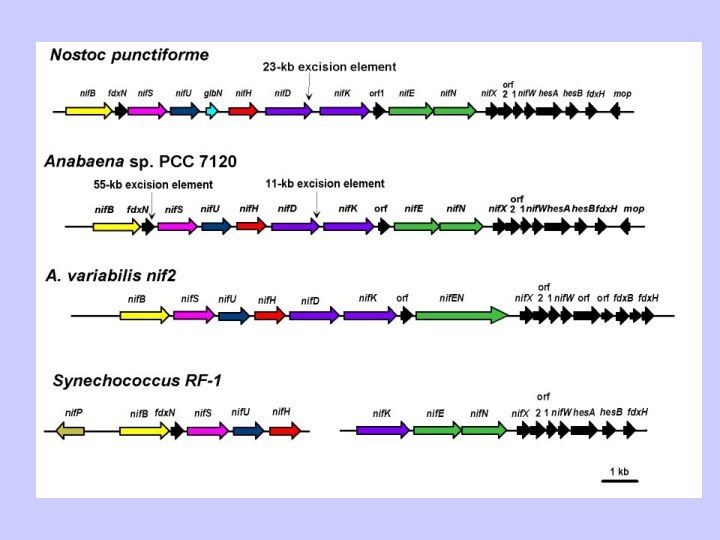


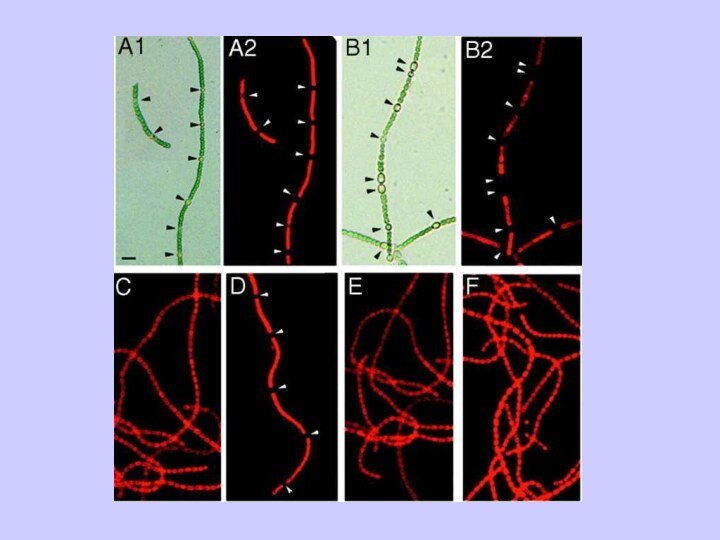
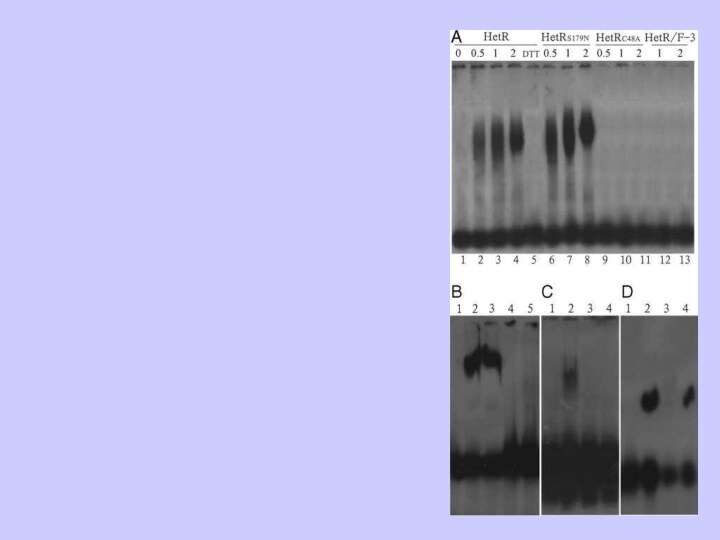
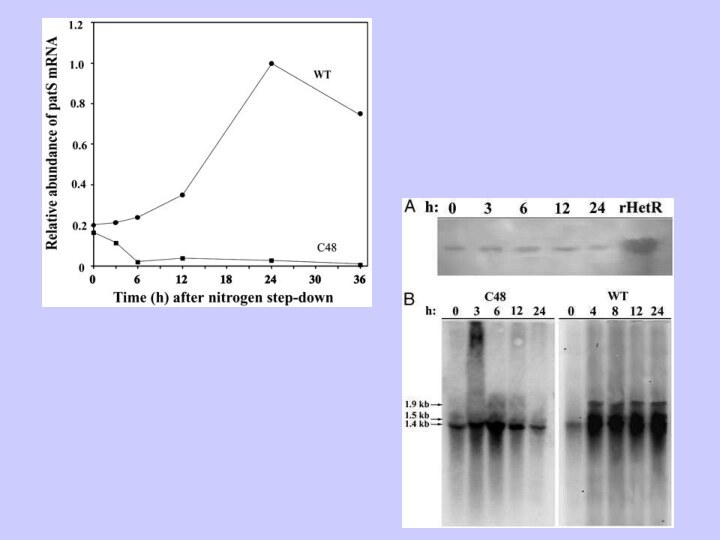
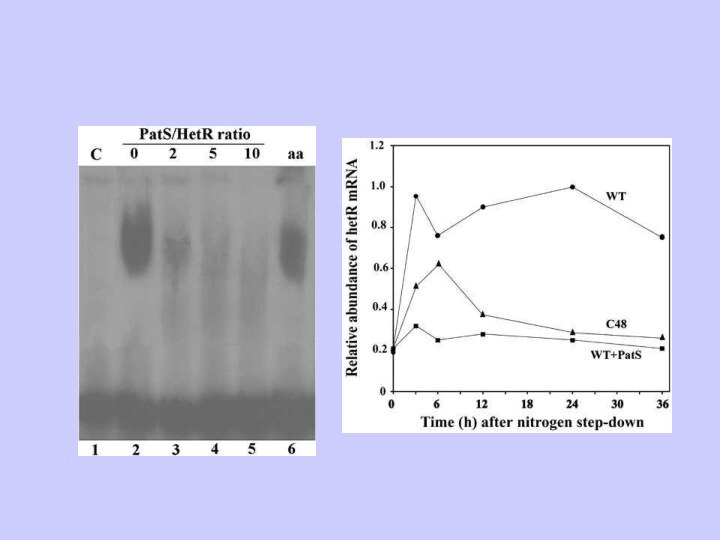
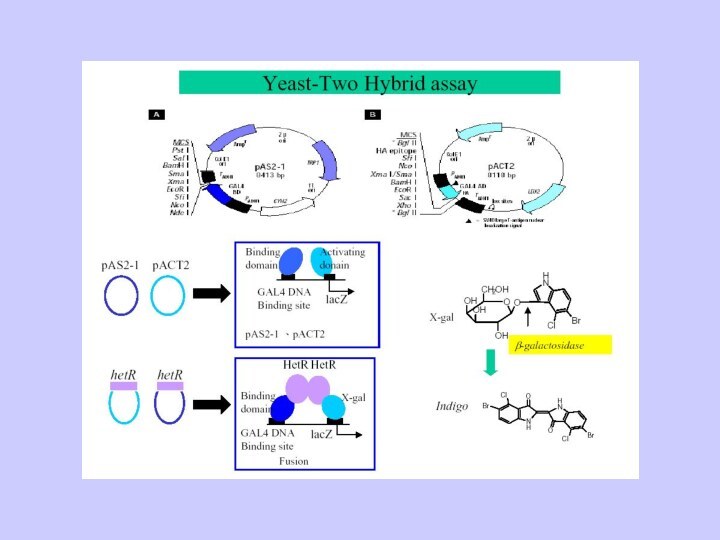
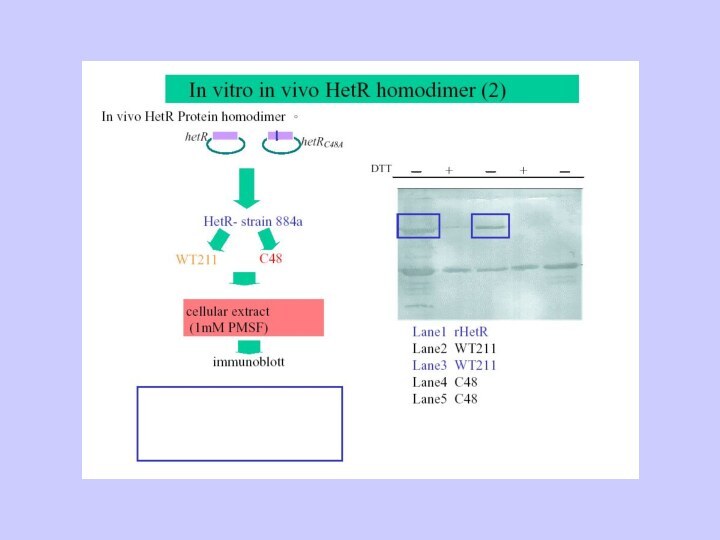

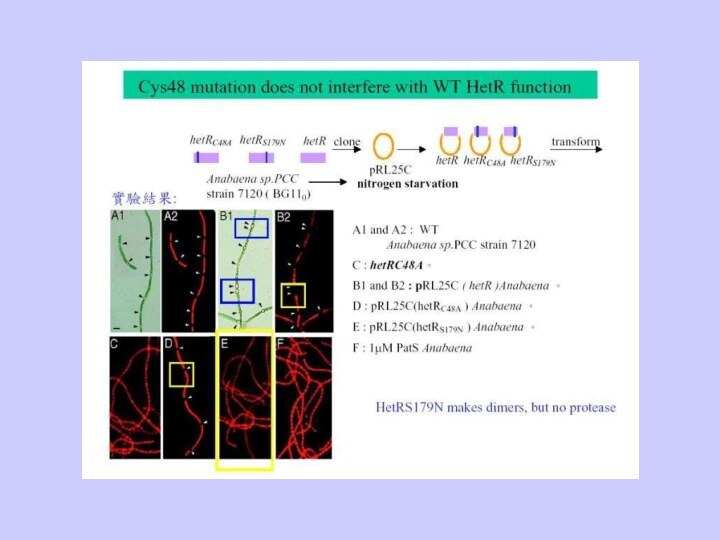
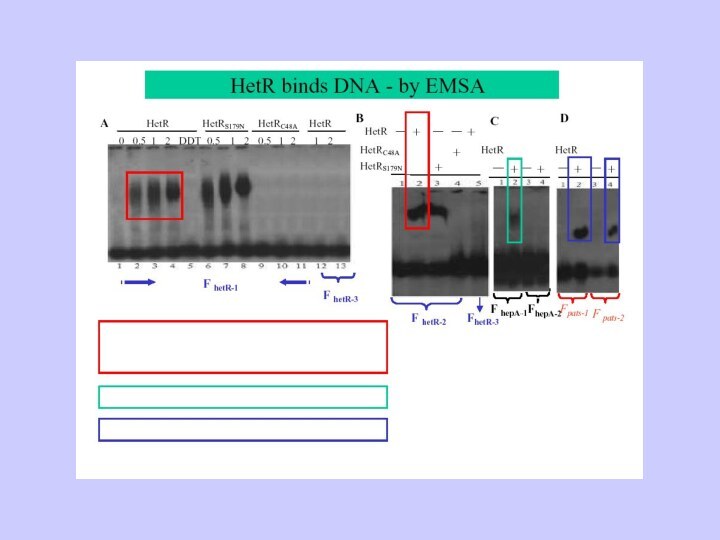
Слайд 6 Figure 21-63. Two strategies for using signal concentration
gradients to specify a fine-grained pattern of cells in
different states. In (A) there is only one signal gradient, and cells select their states by responding accurately to small changes of signal concentration. In (B) the initial signal gradient controls establishment of a small number of more local signals, which control establishment of other still more narrowly local signals, and so on. Because there are multiple local signals, the cells do not have to respond very precisely to any single signal in order to create the correct spatial array of cell states. Case B corresponds more closely to the strategy of the real embryo.Слайд 8 Figure 21-65. The formation of ftz and eve
stripes in the Drosophila blastoderm. Genes ftz and eve
are both pair-rule genes. Their expression patterns (shown in brown for ftz and in gray for eve) are at first blurred but rapidly resolve into sharply defined stripes. (From P.A. Lawrence, The Making of a Fly. Oxford, UK: Blackwell, 1992.)
Слайд 13
Paradox of developmental biology
How is it that a
single cell gives rise to a multicellular organism composed
of 100s of different cell types – yet all the cell types have the same genes?How Cyanobacteria Count to 10
Robert Haselkorn
Jak každá desátá buňka ví že má být heterocystou
Слайд 15
N2 + 8H+ + 8e- + 16ATP -->
2NH3 + H2 + 16ADP + 16Pi
Note: Very expensive
Reason why N2 fixation by heterotrophic microbes is probably low
Key enzyme: nitrogenase (nif)
Ancient enzyme: highly conserved in very diverse microbes, from archaea to cyanobacteria
Biochemistry of N2 fixation
Слайд 16
What is another problem with nitrogenase?
Nitrogenase is killed
dead by O2
Protects nitrogenase (N2 fixing enzyme) from O2
Outside
sources of O2O2 produced by cyanobacteria
Слайд 21 How does Trichodesmium (and single cell cyano’s) fix
N2 without heterocysts?
Partial answer: doesn’t fix N2 and do
photosynthesis at the same timeSee Berman-Frank et al. Science (2001) 294: 1534-1537.
Слайд 22 1. Site of N2 fixation in many cyanobacteria.
2. Specialized thick wall cells in chain of cyanobacterial
vegetative cells3. No PS II of photosynthesis --> no O2 evolution
4. No carbon fixation
5. Respiration
What are heterocysts?
Слайд 23 The heterocyst achieves a near anoxic state by
at least three means.
First, photosystem II, the O2-producing
end of the photosynthetic electron transport chain, is dismantled during heterocyst differentiation, so that
the heterocyst need contend only against O2 produced by neighboring
vegetative cells and that dissolved in the environment. Second, heterocysts are
invested with a specialized envelope that limits the influx of gases.
Two layers within the envelope have been implicated in O2 protection:
an inner layer composed of a hydroxylated glycolipid and an outer layer
of polysaccharide. Neither layer is found in vegetative cells. Third, much of the O2
that overcomes these barriers is consumed by the high oxidase activity associated
with heterocysts.
Слайд 25 Excitation was at 510 to 560 nm (green),
exciting phycoerythrin, and emission was greater than 600 nm.
Heterocysts have negligible fluorescence, while vegetative cells have intense combined fluorescence from phycobiliproteins and chlorophyll a. Bar, 10 µm.A médium s dusíkem
B médium bez dusíku
Слайд 29
Anabaena model
Heterocyst spacing relatively constant
Heterocyst cells
produce compound
Vegetative cells
divide
differentiate
consume
compound
diffuse compound
Слайд 30 First, they assumed that any cell is competent
to differentiate at the moment when nitrogen is removed
from the environment and that the choice of cells that initiate differentiation is random. Second, they postulated the existence of a diffusible inhibitor made by heterocysts and differentiating cells and consumed by nondifferentiating cells, as predicted by experimental data.
Слайд 31
Anabaena – continuous model
axiom: Fh(smax,cmax) Fv(smax,cmax) Fh(smax,cmax)
F(sl,cl)
Fv(s,c) > F(sr,cr):
if s < smax & c >
cminsolve dc/dt = D.(cl+cr-2c)-µ.c
ds/dt = r . s
if s = smax & c > cmin
produce Fv(k . smax,c)Fv((1-k) . smax,c)
if c = cmin
produce Fh(s,c)
Fh(s,c):
solve ds/dt = rs . (smax-s)
dc/dt = rc . (cmax-c)
Слайд 34
Case of the Hidden Heterocyst
Strategy to find heterocyst
differentiation genes
1. Use transposon mutagenesis
Слайд 35
Case of the Hidden Heterocyst
Strategy to find heterocyst
differentiation genes
Nostoc genome
Transposon
1. Use transposon mutagenesis
to find a mutant
defective in heterocyst differentiation
Слайд 36
Case of the Hidden Heterocyst
Strategy to find heterocyst
differentiation genes
Nostoc genome
2. Sequence out from transposon
AAGCTTGACCAAAAAGTTAAAACACTGACGGCAAATAATCAATGACTATCAGACAGAGAATCATCGTGCTGTCAGTAAAACCTCTGATTTCGATCTTTACCATAATTGTTATGTTGTAATGACTAACCAGACTATCTTTTACAGAGCTTCTGGTTAACACTTGTCTAATTAGACATTGATAATGTTTGTGGGGGTTGGTCATCAGGAATGGTAAATAGCAATTACCCTTCAGACTTTCCTATGAGACGCTCCGCCAACGAGCAGTGTCTCTTAAAGAACGTTATGAGCGCTCAGTTAACTTCAGAAATTCACGGCGGAAATCCATAGTTATTATTACTTATGACTAAAACAAAATTACTATGGCGGCTTGTTTAATATAGATTCTGTGTTCTGAGAAATGACTTTTAAAGTCCCACTAACTTTTTTCTCATCTATTGCTATATTTCGACTTTAAAACTTATAGTAGATGGCTTAATTCTCAAATAACAAACTCATTTTTAGTAGATATTTCATGCAAACTGAGGTTTTTAGTGATATTTTCCCCTTATTGAGTACAGCCACTCCACAAACCTTAGAATGGCTACTCAATATTGCAATTGATCATGAATATCCCACTGGTAGAGCAGTTTTAATGGAAGATGCCTGGGGTAATGCAGTTTATTTCGTTGTATCTGGATGGGTAAAAGTTCGGCGCACCTGTGGA
1. Use transposon
mutagenesisto find a mutant defective in heterocyst differentiation
Слайд 37
Case of the Hidden Heterocyst
Strategy to find heterocyst
differentiation genes
Nostoc genome
2. Sequence out from transposon
AAGCTTGACCAAAAAGTTAAAACACTGACGGCAAATAATCAATGACTATCAGACAGAGAATCATCGTGCTGTCAGTAAAACCTCTGATTTCGATCTTTACCATAATTGTTATGTTGTAATGACTAACCAGACTATCTTTTACAGAGCTTCTGGTTAACACTTGTCTAATTAGACATTGATAATGTTTGTGGGGGTTGGTCATCAGGAATGGTAAATAGCAATTACCCTTCAGACTTTCCTATGAGACGCTCCGCCAACGAGCAGTGTCTCTTAAAGAACGTTATGAGCGCTCAGTTAACTTCAGAAATTCACGGCGGAAATCCATAGTTATTATTACTTATGACTAAAACAAAATTACTATGGCGGCTTGTTTAATATAGATTCTGTGTTCTGAGAAATGACTTTTAAAGTCCCACTAACTTTTTTCTCATCTATTGCTATATTTCGACTTTAAAACTTATAGTAGATGGCTTAATTCTCAAATAACAAACTCATTTTTAGTAGATATTTCATGCAAACTGAGGTTTTTAGTGATATTTTCCCCTTATTGAGTACAGCCACTCCACAAACCTTAGAATGGCTACTCAATATTGCAATTGATCATGAATATCCCACTGGTAGAGCAGTTTTAATGGAAGATGCCTGGGGTAATGCAGTTTATTTCGTTGTATCTGGATGGGTAAAAGTTCGGCGCACCTGTGGA
1. Use transposon
mutagenesisto find a mutant defective in heterocyst differentiation
3. Find gene boundaries
4. Identify gene
Do it
Слайд 38
HetR
mutant - unable to make heterocysts
The spatially patterned
differentiation of heterocysts in the filamentous cyanobacterium Anabaena requires
a functional hetR genelow level of transcript when Anabaena is grown with combined nitrogen
induction begins within 2 h following nitrogen deprivation
by 3.5 h, induction is localized to spaced foci
by 6 h, 20-fold increase within spatially separated cells
positive autoregulation
Слайд 40
HetR
Genes
needed for differentiation
Master
regulator
Differentiation in cyanobacteria
Integration of
signals through HetR
Position in filament
Position in cell cycle
Nitrogen deprivation
????
??
Слайд 41
Promoter
NNNNNNNNNNNNNNNNNNATGNNNNNNNNNNNNNNNN NNNNNNNNNNNNNNNNNNTACNNNNNNNNNNNNNNNN
hetR gene
How might hetR be controlled?
5’-GTANNNTACNNNNNNNNNNTANNNTNNNNNNNNNN
3’-CATNNNATGNNNNNNNNNNATNNNANNNNNNNNNN
Presence of fixed nitrogen
No HetR protein
Transcription
Absence of fixed nitrogen
Слайд 42
NNNNNNNNNNNNNNNNNNATGNNNNNNNNNNNNNNNN NNNNNNNNNNNNNNNNNNTACNNNNNNNNNNNNNNNN
hetR gene
5’-GTANNNTACNNNNNNNNNNTANNNTNNNNNNNNNN
3’-CATNNNATGNNNNNNNNNNATNNNANNNNNNNNNN
RNA Polymerase
Absence of fixed nitrogen
How might hetR be controlled?
Слайд 43
NNNNNNNNNNNNNNNNNNATGNNNNNNNNNNNNNNNN NNNNNNNNNNNNNNNNNNTACNNNNNNNNNNNNNNNN
hetR gene
5’-GTANNNTACNNNNNNNNNNTANNNTNNNNNNNNNN
3’-CATNNNATGNNNNNNNNNNATNNNANNNNNNNNNN
RNA Polymerase
Absence of fixed nitrogen
How might hetR be controlled?
HetR protein
Transcription
Слайд 44 The key result of this experiment is that
all of the upstream controls of HetR expression can
be bypassed; expression of HetR alone suffices to turn on the differentiation pathway.HetR overexpression
Слайд 46
PatS
overexpression of patS completely blocks heterocyst development
patS encode
a 17- or 13-amino-acid peptide, is crucial for the
formation and maintenance of the normal heterocyst patternСлайд 47 Wild-type filaments (A) grown in BG-11 medium and
(B) after the nitrogen step-down in BG-110 to induce
heterocysts (arrowheads) are shown. (C) Overexpression of patS prevented heterocyst formation in BG-110, and (D) deletion of patS resulted in supernumerary heterocysts with an abnormal pattern in BG-110. Differential interference contrast micrographs were taken before (A) and 24 hours after (B through D) heterocyst induction.patS controls heterocyst development in Anabaena PCC 7120
Слайд 48 The exogenous addition of a pentapeptide corresponding to
the last five COOH-terminal residues of PatS also inhibited
heterocyst differentiation, indicating that a processed form of PatS may be a diffusible inhibitory signal regulating development.R G S G R
Слайд 49
Přesně jako v modelu
z roku 1975
The inhibition of neighboring cells by select differentiating cells (lateral inhibition) is an important mechanism of pattern formation in eukaryotic organisms.
Слайд 50
Because it takes ~20 hours for heterocysts to
mature and begin supplying fixed nitrogen to the filament,
a specialized early inhibitory signal is required to allow only a fraction of starving cells to terminally differentiate.The first cells to differentiate increase the production of PatS to inhibit neighboring cells from forming heterocysts. PatS-producing cells must themselves be refractory to the PatS signal.





























